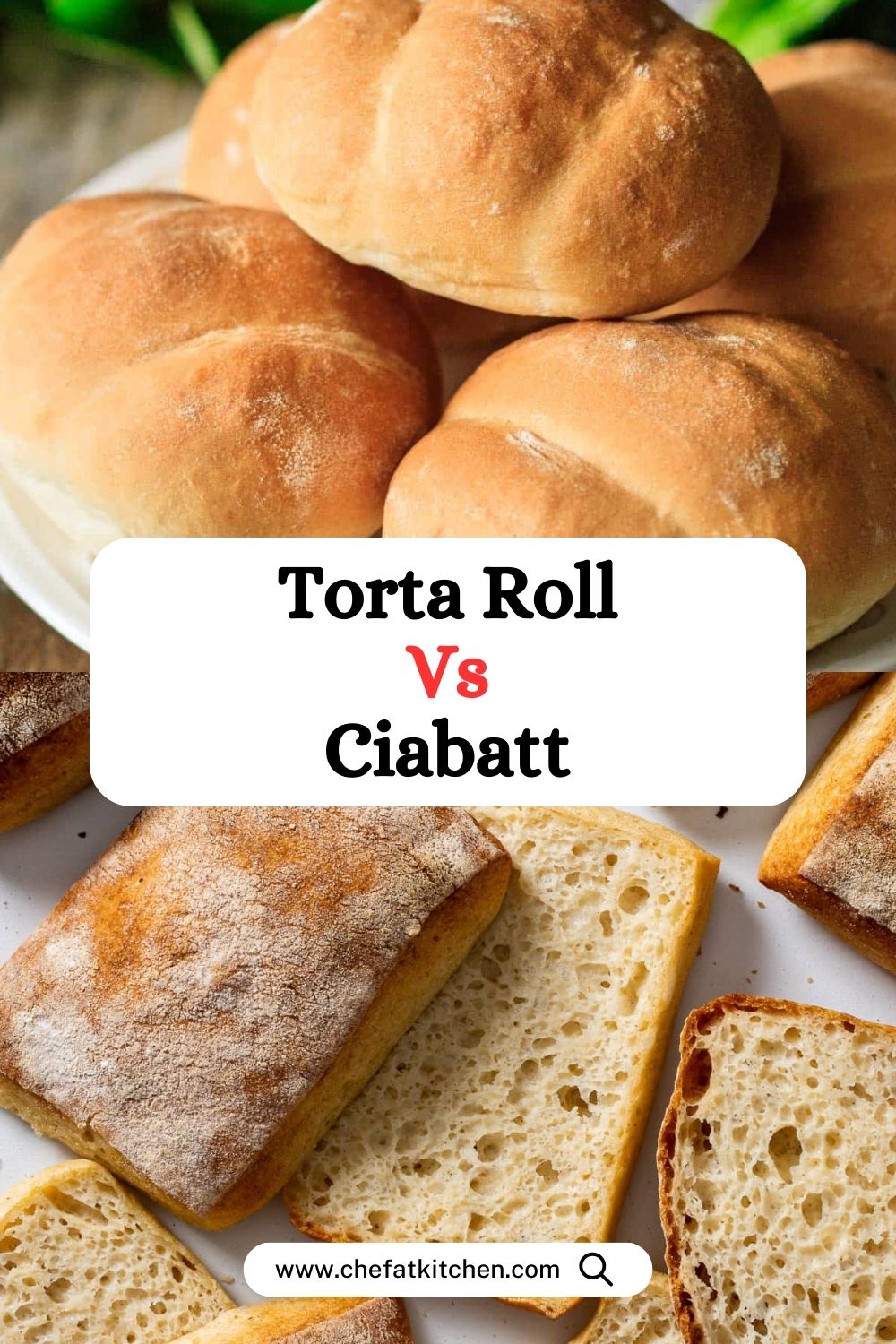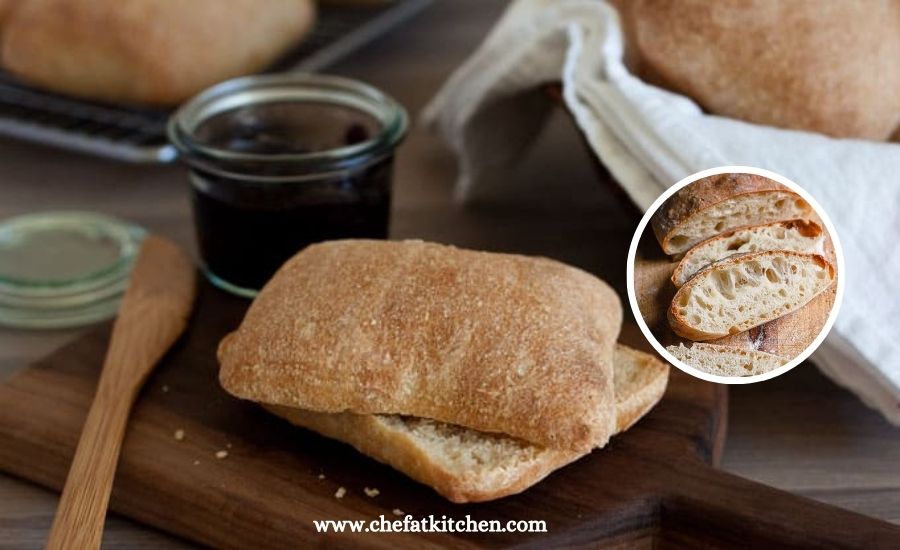Every product is independently reviewed and selected by our editors. If you buy something through our links, we may earn an affiliate commission at no extra cost to you.
When it comes to Italian bread, two contenders stand out in the culinary arena – the Torta Roll and the Ciabatta.
These iconic bread varieties have their own unique characteristics, flavors, and uses in the culinary world.
In this article, we’ll delve into the delicious details of Torta Roll vs. Ciabatta, exploring their origins, ingredients, textures, and the best ways to savor these delightful bread options.
Torta Roll Vs Ciabatt – Brisk Comparison

It seems like there might be a slight confusion in your question, as “Torta Roll” and “Ciabatta” are two different types of baked goods.
| Feature | Torta Roll | Ciabatta |
|---|---|---|
| Origin | Italy | Italy |
| Shape | Typically round | Elongated with a flat, broad shape |
| Crust | Thin and soft | Crusty and chewy |
| Interior Texture | Soft, airy, and slightly sweet | Open, airy crumb with large holes |
| Ingredients | Flour, water, yeast, salt, (sugar), olive oil | Flour, water, yeast, salt, (olive oil) |
| Dough Hydration | Moderate | High |
| Flavor | Mild and slightly sweet | Robust with a slight tang |
| Fermentation Time | Shorter | Longer, contributing to flavor development |
| Uses | Sandwiches, paninis, sweet and savory fillings | Bruschettas, paninis, dipping in olive oil, hearty sandwiches |
| Texture Contrast | Less contrast between crust and crumb | Marked contrast between crust and crumb |
If you meant to compare a specific type of rolled cake to ciabatta bread or if you have a particular context in mind, please provide more details so I can offer more accurate information.
Otherwise, if you have a specific “Torta Roll” in mind, it would be helpful to know the ingredients or characteristics you’re referring to.
Ingredients And Preparation
The key to a delicious Torta Roll or Ciabatta bread lies in the choice of ingredients and the way they are prepared.
Let’s explore the unique components that make these bread varieties so enticing and discover the steps involved in creating these culinary delights.
Key Ingredients In Torta Roll
Torta Rolls are a popular choice for sandwich lovers, known for their soft interiors and slightly crispy crusts.
Here are the key ingredients that contribute to the deliciousness of a Torta Roll:
- Flour: The main ingredient, usually all-purpose or bread flour, provides structure and texture to the roll.
- Yeast: Active dry yeast or instant yeast helps the dough rise and develop a fluffy interior.
- Water: A crucial component for activating the yeast and creating a moist dough.
- Salt: Enhances the flavor and helps to control the yeast’s fermentation process.
- Oil: Adds moisture and tenderness to the roll while protecting it from drying out.
Preparation Of Torta Roll
- Mix the flour, yeast, salt, water, and oil in a bowl, forming a sticky dough.
- Knead the dough on a floured surface until it becomes smooth and elastic.
- Allow the dough to rise in a warm place until it doubles in size, usually for about an hour.
- Punch down the dough to release any air bubbles and shape it into individual rolls.
- Let the rolls rest for a short period, allowing them to rise slightly again.
- Bake the Torta Rolls in a preheated oven until they turn golden brown and sound hollow when tapped.
- Cool the rolls on a wire rack, and they are ready to create mouthwatering sandwiches.
Key Ingredients In Ciabatta Bread
Ciabatta bread, originating from Italy, is known for its airy texture and crusty exterior.
Let’s delve into the essential ingredients that contribute to the distinctive characteristics of Ciabatta bread:
- Flour: Typically made with high-gluten flour or bread flour to achieve the desired elasticity.
- Yeast: Either fresh or instant yeast can be used to help the dough rise and create those big air pockets.
- Water: The high hydration in Ciabatta dough results in large air bubbles and a chewy texture.
- Salt: Enhances the flavor and helps control the fermentation process.
Preparation Of Ciabatta Bread
- Mix the flour, yeast, salt, and water until a sticky dough forms.
- Knead the dough gently until it becomes smooth and stretchy.
- Allow the dough to rest and rise for several hours, allowing it to develop flavor and structure.
- Shape the dough into long, rectangular loaves, taking care not to compress out too much air.
- Let the loaves proof on a baking sheet until they rise again and form a slightly flattened shape.
- Bake the Ciabatta bread in a hot oven, preferably on a stone or baking tray, until it turns golden brown.
- Cool the loaves on a wire rack before slicing and enjoying the light, airy interior.
Texture And Taste
Discover the distinct textures and tastes of Torta Roll and Ciabatta bread.
While Torta Roll offers a soft and fluffy interior with a slightly crusty exterior, Ciabatta boasts a chewy and holey texture, perfect for soaking up flavors.
Experience the unique character of each bread in your next culinary creation.
Texture Of Torta Roll
The Torta Roll, also known as a Mexican sandwich roll, is renowned for its unique texture. This bread has a crusty exterior with a soft and airy interior.
The texture of the Torta Roll is what sets it apart from other bread options.
The perfectly baked crust offers a slight resistance when bitten into, giving the sensation of a delightful crunch.
As you continue to chew, the soft insides of the Torta Roll provide a pleasantly light and fluffy texture that melts in your mouth.
Its combination of crunch and softness makes it an ideal choice for a variety of fillings.
Texture Of Ciabatta Bread
Ciabatta bread, originating from Italy, is known for its distinct texture. This bread has a rustic and chewy texture with a moist interior.
The crust of a Ciabatta bread is thin and crisp, contributing to its overall texture.
When you bite into a slice of Ciabatta, you’ll discover a slightly firm resistance followed by a delightfully soft and porous texture.
The interior of Ciabatta bread is characterized by large air pockets, resulting in a light and airy feel.
Its chewiness gives a satisfying experience to the taste buds, making it a versatile option for various dishes.
Taste Of Torta Roll
The classic Torta Roll has a mild, neutral flavor that allows the fillings to take center stage.
This subtle taste complements a wide range of ingredients, from savory meats to fresh vegetables and creamy spreads.
The lightly seasoned bread offers a pleasant background flavor that enhances the overall taste of the sandwich fillings.
Whether you prefer traditional Mexican flavors or a fusion of international cuisines, the Torta Roll’s taste provides a perfect base for creating a delicious and satisfying meal.
Taste Of Ciabatta Bread
Unlike the neutral taste of the Torta Roll, Ciabatta bread has a distinct and flavorful profile.
The bread’s fermentation process adds a touch of acidity, resulting in a slightly tangy taste that is both unique and enjoyable.
The crust of the Ciabatta bread, with its golden brown color, provides a delightful contrast to the soft and tangy interior.
Its robust flavor complements both savory and sweet fillings, making it a versatile option for sandwiches, bruschettas, or even as a standalone bread accompanied by a drizzle of quality olive oil.
The taste of Ciabatta bread is sure to leave a lasting impression on your palate.
Comparison of Torta Roll and Ciabatta Bread
| Aspects | Torta Roll | Ciabatta Bread |
|---|---|---|
| Texture | Airier and softer interior with a crusty exterior | Chewy with large air pockets and a crispy crust |
| Taste | Neutral taste that complements fillings | Slightly tangy flavor that stands out |
Cultural Significance
The cultural significance of bread in culinary traditions runs deep, reflecting the unique flavors and culinary customs of different regions.
Torta roll and ciabatta bread are integral to the culinary heritage of various cultures, playing a crucial role in local cuisines and food traditions.
Role Of Torta Roll In Culinary Traditions
The torta roll, with its soft and fluffy texture, is a staple in Mexican cuisine, where it serves as the foundation of numerous traditional dishes such as tortas, a type of Mexican sandwich.
The versatile nature of the torta roll allows it to be filled with a diverse range of ingredients, reflecting the rich culinary heritage and diverse flavors of Mexican cuisine.
Role Of Ciabatta Bread In Culinary Traditions
Ciabatta bread, originating from Italy, holds a significant place in Italian culinary traditions.
Its distinct open crumb and crisp crust make it a favored choice for panini, bruschetta, and various Italian sandwiches.
The ciabatta’s porous structure allows it to absorb flavors, making it an essential component in showcasing the robust and authentic tastes of Italian cuisine.
Variations And Regional Differences
To exploring the world of bread, one cannot overlook the beauty of regional variations and differences in the Torta Roll and Ciabatta bread.
These bread variations have their unique characteristics, shapes, and flavors, which often reflect the culinary diversity of different regions.
Let’s take a closer look at the regional variations of Torta Roll and Ciabatta bread.
Regional Variations Of Torta Roll
The Torta Roll, also known as “pan de torta,” is a traditional Mexican bread that varies significantly depending on the region.
In the northern areas of Mexico, the Torta Roll is typically a soft, slightly sweet bread with a tender crumb, ideal for sandwiches or to accompany meals.
However, in central and southern Mexico, the Torta Roll tends to have a firmer crust and a heartier texture, making it suitable for dipping in soups or stews.
Regional Variations Of Ciabatta Bread
Originating from Italy, Ciabatta bread also exhibits regional differences in its preparation and characteristics.
In the northern regions, Ciabatta bread may have a thicker crust and a chewier crumb, while in central and southern Italy, it is often lighter and airier, making it perfect for sandwiches or to pair with antipasti.
Can I Use Torta Roll Instead Of Ciabatta For A Sandwich?
Yes, you can use torta roll instead of ciabatta for a sandwich.
However, keep in mind that torta roll has a softer texture and slightly sweeter taste, so it may alter the overall flavor and texture of your sandwich.
Which Bread Is Better For Garlic Bread, Torta Roll Or Ciabatta?
Both torta roll and ciabatta can be used to make delicious garlic bread.
Torta roll’s soft texture allows for a melt-in-your-mouth experience, while ciabatta’s crusty exterior provides a satisfying crunch.
Ultimately, the choice depends on your personal preference and the specific flavor and texture you desire for your garlic bread.
Can I Freeze Torta Roll And Ciabatta Bread?
Yes, both torta roll and ciabatta bread can be frozen. It’s best to wrap them tightly in plastic wrap or place them in airtight freezer bags before freezing.
When ready to use, let them thaw at room temperature or reheat in the oven for a few minutes to restore their freshness.
Conclusion
Both the Torta Roll and Ciabatta have earned their places in the hearts and kitchens of food enthusiasts worldwide.
Whether you’re creating a simple sandwich or exploring the world of gourmet cuisine, these Italian breads offer a delightful array of textures and flavors.
So, the next time you’re faced with the delightful dilemma of Torta Roll vs. Ciabatta, embrace the versatility of both and let your taste buds be the ultimate judge.

